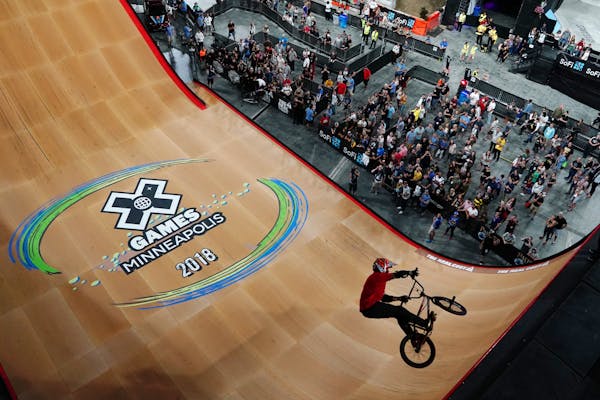There was no preparation adequate for the MegaRamp's annual debut Friday night.
The summer X Games' biggest attraction, literally, has no equal. Athletes practice on a couple of impostors in California. They're not as steep. They're not as smooth, so they're not as fast. Only experience soothed Mykel Larrin's nerves before he and his BMX bike rode an elevator eight stories to the top.
The 82-foot tall MegaRamp is the symbol of the X Games' namesake — extreme games. Athletes are constantly seeking the next jaw-dropping feat. But even though the ramp entered its 15th summer for skateboarders and 13th for BMX riders, there's a feeling among athletes that it's the current pinnacle of their progression in action sports. Few might ever dare to dream bigger.
"It keeps you honest," said Larrin, a bronze medalist in BMX Big Air. "That's the biggest thing. Because when it goes wrong, it goes pretty wrong."
Everybody saw how wrong Friday night during the Big Air competition.
The stadium crowd let out an audible groan, then hushed as Colton Satterfield lay separated from his light blue bike. Satterfield, a two-time Big Air gold medalist, held up a thumb and pinkie with his right hand while strapped to a backboard and carted off the track. He wrecked on his first run while descending the 27-foot quarterpipe at the end of the MegaRamp.
Satterfield was immediately ruled out of competition. He was evaluated for clavicle and possible head injuries, according to ESPN public relations.
James Foster defended his BMX Big Air gold medal with another gold run — after Satterfield's crash.
"You have to try to block it out of your mind," Foster said, "because if you think about that stuff when you ride, you can't ride."
Foster threw down a superman seat grab over the gap and four tailwhips on the ensuing quarterpipe.
"I would never do any of that stuff I just did out of competition," Foster said. "Because of the level of risk."
The crash is a dark side of soaring above the second deck of U.S. Bank Stadium.
"My first experience was watching it on TV," said Larrin, who placed fourth on Friday night. "I was at home like, 'Oh my that's crazy, look at that ramp.' In my head, it's progression. So you jump off a curb, then you're doing a box jump and so forth and you build up to that. But there's never been anything like this since Mat Hoffman did that back in the day."
Larrin credits Hoffman, the BMX Vert pioneer, with first pushing the boundaries of ridiculous air. In the early 1990s, Hoffman constructed his own gigantic ramp, dubbed "The Big Ramp," to chase the record for world's highest air on a BMX bike.
This was before the Internet became popular. The world didn't get a glimpse of Hoffman's 20-foot tall quarterpipe until photos emerged in a Hoffman Bikes advertisement in June 1992.
"When the ad debuted, there were people who didn't believe it," Hoffman told ESPN five years ago. "Even though I had a reputation for doing high airs, I was also notorious for having a goofy sense of humor."
So began the idea for something like the MegaRamp.
"It took me awhile," Skateboard Big Air gold medalist Elliot Sloan recalled of his first-ever MegaRamp run. "Probably the first few months, getting up there and looking at it and going 'Not today.' "
But now Sloan keeps coming back. He'll try to defend his gold medal in Saturday's Skateboard Big Air final with a kickflip 720 over the mega gap, which has never been done in Big Air competition. He's landed three in practice runs on "smaller" MegaRamps located at Woodward West Skatepark and behind Bob Burnquist's house in California.
Even some fellow action sports stars aren't game for the Mount Everest of the X Games.
"It has to be scary to have to come from that to this," Women's Park skateboarder Nicole Hause said. "You guys are amazing, because I think about it and I'm like 'Nah, probably not. Probably not even one day.' "
Anze Kopitar scores in overtime, Kings beat Oilers 5-4 in Game 2 to tie series
Thunder's Holmgren bests Pelicans' Valanciunas in center matchup to help OKC take 2-0 lead
AP PHOTOS: Russian kids ride sticks with a horse's head in hobby horsing competition
Defending champion Golden Knights beat Stars 3-1 to take 2-0 series lead home to Vegas

